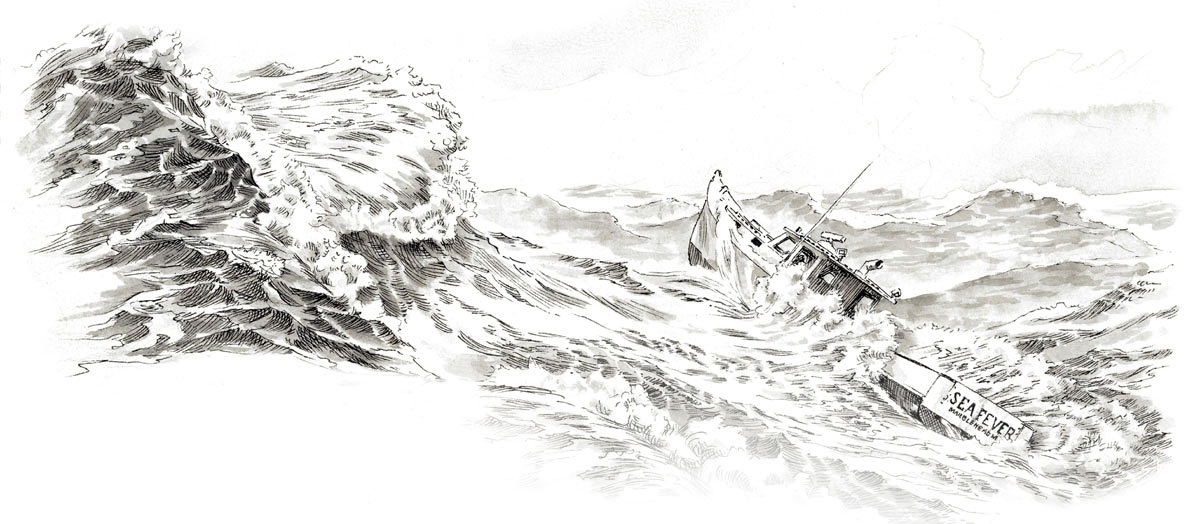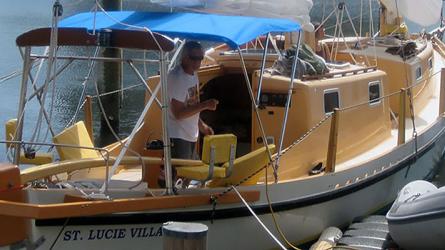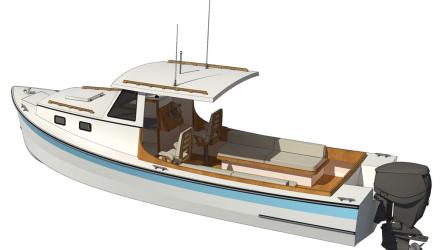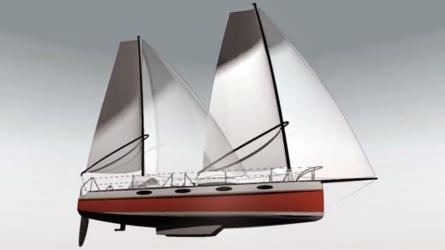The Gift of SEA FEVER
How My Father Saved My Life
How My Father Saved My Life

My name is Peter Brown. I’m the son of Bob Brown, who was a pioneer in the New England offshore lobster fishery. And I am the grandson of the naval architect K. Aage Nielsen.
In the late 1960s, my father and my mother, Linda Nielsen, asked my grandfather to design a lobsterboat that could go 130 miles offshore. The boat, which was 49′7″ long and named SEA FEVER, was built by Sonny Hodgdon in East Boothbay, Maine. She was beautiful—heavily built with oak frames and mahogany planks. SEA FEVER was a great sea boat, although she was a bit rolly because she was narrower, had slacker bilges, and had more rounded chines than most boats in the business. Most offshore boats have hard chines or firm bilges and are beamy, but my grandfather wanted her to have a soft turn of the bilge because he felt it would make her more seaworthy than other boats if the weather were to get really bad.
My grandfather was known for having very strong opinions about the details of his designs. These opinions came from experience—at sea, in boatbuilding shops, and in the design office. Throughout his career, he did not design “production”-style boats. He did only custom designs, and he chose the builders and personally supervised each construction project. Tom Jackson and Maynard Bray titled their biography of my grandfather Worthy of the Sea, and that’s a good description of the boats he designed—and, as I would learn, of SEA FEVER. On the cover of that biography is a quote from my grandfather that sums up his approach to his work: “Good enough is not a sufficient goal.”
So, this is my story of how, essentially, my grandfather saved my life.
In 1980, as a young man in my early 20s, I found myself captaining SEA FEVER out of Marblehead, Massachusetts. I was on my second season with her and, although I was young, I was the son of an offshore lobsterman and I felt confident in my abilities even at that age.
We left for a trip on the Friday before Thanksgiving with a forecast wind of 15 to 20 knots for the next day. Remember, we were fishing 130 miles offshore, so were always looking at the forecast for the next day or so, as it takes 20 to 22 hours to simply get to the fishing grounds. So, we headed out on SEA FEVER in hopes of having a profitable trip and good weather. But the forecast was not accurate.
Through the early hours of Saturday morning the wind just kept coming on, and we found ourselves more than 100 miles offshore in hurricane-force winds. The seas built to over 30′ with even bigger waves at times. All we could do was keep the bow up into the wind and pray.
Around 10 a.m. I saw a wave that definitely had our name on it, if you know what I mean. It was huge, with a big breaking comber on it. I tried to get the boat to the top of it but that wave was just too big!
The wave hit SEA FEVER and broke the windows in. It’s a terrible situation when the weather is bad and you really can’t do anything and there is nowhere to go. I turned down-sea and prepared to make the repairs to the window. Just before I was about to head out to the foredeck, we took another huge sea from the stern that broached us and slammed SEA FEVER hard on her starboard side. That wave washed one of my crew members overboard. His name was Gary Brown. We made many attempts to rescue him, but we couldn’t. He drowned, lost at sea. My last sight of him is something I will never forget.
We were in one hell of a bad situation and we were in a wooden boat, a very small boat for being 130 miles offshore in that kind of weather. We couldn’t go into it, and we couldn’t go downwind, so I decided to let the boat go side-to the seas. I am sure you are already thinking, “That’s a bad move,” and at this point in time I would agree. But at that time it seemed to be the only sensible move. We got picked up by huge waves and went skidding down the front of them, and when we got to the bottoms of the waves SEA FEVER got slammed down. It was extremely terrifying, and there are no words to describe it. With the storm lasting more than 15 hours, and the boat taking a tremendous beating and with some frame damage, it’s amazing the boat survived.
Why SEA FEVER didn’t roll over is still beyond belief. There is no way a boat like that, hit broadside and under those conditions, should make it.
Today, I remember what my grandfather said while designing SEA FEVER. Despite the fact that she’d be more rolly than the other boats of the fleet, he insisted on the narrower-than-usual hull, the steeper deadrise angle, the softer turn of the bilge. He said she would be more seaworthy that way. A typical firm-bilged or hard-chined boat would have tripped and capsized while skittering beam-to down the faces of those waves. SEA FEVER survived because of my grandfather’s stubborn insistence on her unusual hull shape.
So, I want to say “Thank you, Grampy” for being so demanding. Because of your design, I am here today. 
Peter Brown is a commercial fisherman and owner of the F/V RACHEL LEAH. His home port is Hyannis, Massachusetts.






